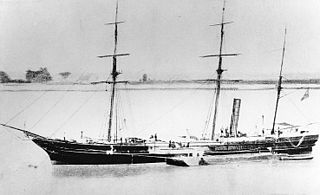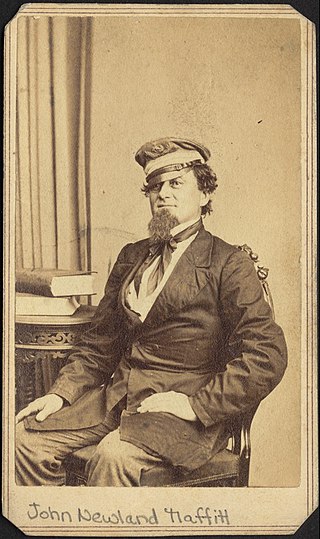
Thomas B. Huger (died April 25, 1862) was an officer in the Confederate States Navy during the U.S. Civil War. Before the war, he had served for over 20 years in the United States Navy.

Thomas B. Huger (died April 25, 1862) was an officer in the Confederate States Navy during the U.S. Civil War. Before the war, he had served for over 20 years in the United States Navy.
Huger was born in South Carolina. He joined the U.S. Navy as a midshipman in March 1835. In 1845 he married Mariamne Williams Meade, the daughter of merchant Richard W. Meade and sister of Civil War general George Meade; she died in 1857. [1] Huger was promoted to the rank of Lieutenant in February 1848 and continued in the service until his native state seceded from the United States. Resigning his commission in the U.S. Navy in January 1861, he became a First Lieutenant in the Confederate Navy the following March.
He commanded a battery on Morris Island, South Carolina in 1861 and was appointed as commanding officer of the gunboat CSS McRae later in that year. Huger's ship operated in defense of New Orleans, Louisiana and the lower Mississippi River.
On April 24, 1862, while battling Federal Navy ships near Fort Jackson and Fort St. Philip, McRae was badly damaged and Lieutenant Huger was mortally wounded. He died the next day.
Huger was wounded while engaged in fighting the Iroquois—a ship on which he served while in the US Navy. After he was wounded, his former shipmates recognized him and raised their caps as a token of respect. After his wounding, he was brought back to Charleston, South Carolina. On his death bed, he was informed that a US Navy officer wanted to see him. Huger responded, “Let him come in; I have no enemies now.” When Huger learned the officer’s name and the fact that he was a Southerner fighting for the Union, Huger declined to see him. Union Navy officers attended his funeral.^1

Charles William Read, known commonly as "Savez", was an officer in the antebellum United States Navy and then in the Confederate Navy during the American Civil War. He was nicknamed the "Seawolf of the Confederacy" for his exploits and daring.

CSS McRae was a Confederate gunboat that saw service during the American Civil War. Displacing around 680 tons, she was armed with one 9-inch (229 mm) smoothbore and six 32-pounder (15 kg) smoothbore cannon.

John Lorimer Worden was a U.S. Navy officer in the American Civil War, who took part in the Battle of Hampton Roads, the first-ever engagement between ironclad steamships at Hampton Roads, Virginia, on 9 March 1862.

The Confederate States Marine Corps (CSMC), also referred to as the Confederate States Marines, was a branch of the Confederate Navy during the American Civil War. It was established by an act of the Provisional Congress of the Confederate States on March 16, 1861. The Corps' manpower was initially authorized at 45 officers and 944 enlisted men, and was increased on September 24, 1862, to 1,026 enlisted men. The organization of the Corps began at Montgomery, Alabama, and was completed at Richmond, Virginia, when the capital of the Confederate States was moved to that location. The headquarters and main training facilities remained in Richmond throughout the war, located at Camp Beall on Drewry's Bluff and at the Gosport Shipyard in Portsmouth, Virginia. The last Marine unit surrendered to the Union army on April 9, 1865, with the Confederacy itself capitulating a month later.

Andrew Hull Foote was an American naval officer who was noted for his service in the American Civil War and also for his contributions to several naval reforms in the years prior to the war. When the war came, he was appointed to command of the Western Gunboat Flotilla, predecessor of the Mississippi River Squadron. In that position, he led the gunboats in the Battle of Fort Henry. For his services with the Western Gunboat Flotilla, Foote was among the first naval officers to be promoted to the then-new rank of rear admiral.

Charles Williamson Flusser was an officer in the United States Navy during the American Civil War.

John Newland Maffitt was an officer in the Confederate States Navy who was nicknamed the "Prince of Privateers" due to his success as a blockade runner and commerce raider in the U.S. Civil War.

CSSEllis was a gunboat in the Confederate States Navy and the United States Navy during the American Civil War. It was lost during a raid while under command of famed Navy officer Lieutenant William B. Cushing.

Peter Umstead Murphey was a former officer of the United States Navy who joined the Confederate States Navy during the American Civil War. He was the son of Archibald DeBow Murphey and Jane Armistead Murphey.

John Taylor Wood was an officer in the United States Navy and the Confederate Navy. He resigned from the U.S. Navy at the beginning of the American Civil War, and became a "leading Confederate naval hero" as a captain in the Confederate Navy. He was a lieutenant serving aboard CSS Virginia when it engaged USS Monitor in 1862, one of the most famous naval battles in Civil War and U.S. Naval history. He was caught in 1865 in Georgia with Confederate President Jefferson Davis' party, but escaped and made his way to Cuba. From there, he got to Halifax, Nova Scotia, where he settled and became a merchant. His wife and children joined him there, and more children were born in Canada, which is where he lived out the remainder of his life.

Benjamin Huger was a regular officer in the United States Army, who served with distinction as chief of ordnance in the Mexican–American War and in the American Civil War, as a Confederate general. He notably surrendered Roanoke Island and then the rest of the Norfolk, Virginia shipyards, attracting criticism for allowing valuable equipment to be captured. At Seven Pines, he was blamed by General James Longstreet for impeding the Confederate attack and was transferred to an administrative post after a lackluster performance in the Seven Days Battles.

Harriet Lane was a revenue cutter of the United States Revenue Cutter Service and, on the outbreak of the American Civil War, a ship of the United States Navy and later Confederate States Navy. The craft was named after the niece of senator and later United States President, James Buchanan; during his presidency, she acted as First Lady. The cutter was christened and entered the water for the Revenue Service in 1859 out of New York City, and saw action during the Civil War at Fort Sumter, New Orleans, Galveston, Texas, and Virginia Point. The Confederates captured her in 1863, whereupon she was converted to mercantile service. Union forces recaptured her at the end of war. The U.S. Navy declared her unfit for service and sold her. New owners out of Philadelphia renamed her Elliot Ritchie. Her crew abandoned her at sea in 1881.

Samuel William Preston was an officer in the United States Navy during the American Civil War. He was killed in action during the Second Battle of Fort Fisher.

The Battle of forts Jackson and St. Philip was the decisive battle for possession of New Orleans in the American Civil War. The two Confederate forts on the Mississippi River south of the city were attacked by a Union Navy fleet. As long as the forts could keep the Federal forces from moving on the city, it was safe, but if they fell or were bypassed, there were no fall-back positions to impede the Union advance.

George Burgwyn Anderson was a career military officer, serving first in the antebellum U.S. Army and then dying from wounds inflicted during the American Civil War while a general officer in the Confederate Army. He was among six generals killed or mortally wounded at the Battle of Antietam in September 1862.

USS Isaac Smith was a screw steamer acquired by the United States Navy during the American Civil War. She was used by the Union Navy to patrol navigable waterways of the Confederate States of America to prevent the Confederacy from trading with other countries. In 1863, she became the only warship in the American Civil War to be captured by enemy land forces. She then served in the Confederate States Navy as CSS Stono until she was wrecked.
George Washington Gift (1833–1879), U. S. Navy officer, writer, banker, civil engineer, politician, Confederate Navy officer, businessman, and newspaper editor.

Commodore John R. Goldsborough was an officer in the United States Navy. Goldsborough was made a cadet-midshipman in 1824 and as such saw action in the Mediterranean against pirates. In one incident, while in charge of 18 men he attacked and captured a Greek pirate ship with a 58-man crew.
Francis John Higginson was an officer in the United States Navy during the American Civil War and Spanish–American War. He rose to the rank of rear admiral and was the last commander-in-chief of the North Atlantic Squadron and first commander-in-chief of the North Atlantic Fleet.
Alexander McRae was a U.S. Army officer from North Carolina, who served on the antebellum frontiers in Texas and New Mexico, and fought in the Union Army, being killed in the Battle of Valverde.
1. A Diary from Dixie, Mary Boykin Chesnut, (2006) p 171-172